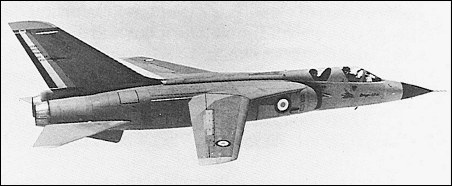|
| On 13 October 1965, Avions Marcel Dassault received a
contract to design and build one prototype of a two-seat
variable-geometry fighter, the Mirage G. Powered
by a single SNECMA (Pratt & Whitney) TF-306E turbofan
rated at 9300kg with afterburning
and owing much to the design of the Mirage F2, the
Mirage G was first flown on 18 November 1967. Wing
sweepback could be varied between 23░ and 70░,
maximum sweep being achieved in flight within a
week of the commencement of trials and a speed of
M=2.1 being attained within two months. Trials were
to continue until 13 January 1971, when the Mirage G
was lost in an accident, 400 hours of flying having been
accumulated in 316 flights. In the meantime, late in
1968, two further prototypes had been ordered, these
each being powered by two 7200kg
SNECMA Atar 9K-50 turbojets. After a succession of designation changes, these emerged as Mirage G8s,
the two-seat first prototype flying on 8 May 1971, and
the single-seat second prototype following on 13 July
1972. The Mirage G8 was envisaged as a multi-role
fighter, capable of fulfilling intercept, patrol, attack and
long-range reconnaissance missions, and was fitted
with Cyrano IV multi-purpose radar, a low-altitude nav/
attack system, a laser rangefinder, Doppler radar and a
bombing computer. The proposed production version was to have been powered by two SNECMA M53 turbofans.
In the event, the Armee de l'Air concluded that the
disadvantages of variable-geometry outweighed its
advantages, and after study of a fixed-geometry version
with 55░ of sweepback (Mirage F8), further development
was discontinued.
| MODEL | Mirage G8 |
| WEIGHTS |
| Take-off weight | 23800 kg | 52470 lb |
| DIMENSIONS |
| Wingspan | 13.00 m | 43 ft 8 in |
| Length | 16.80 m | 55 ft 1 in |
| Height | 5.35 m | 18 ft 7 in |
| Wing area | 37.0 m2 | 398.26 sq ft |
| PERFORMANCE |
| Max. speed | 2495 km/h | 1550 mph |
 | A three-view drawing (1670 x 1117) |
| gerard, e-mail, 29.12.2022 10:22 D'apr├Ęs mes souvenirs, le Mirage G-8 avec deux SNECMA 9k50 devait ├¬tre capable de Mach 3 ? reply | | Dr. Saul Pressman, e-mail, 02.10.2015 20:20 Specs are wrong.
wing span: 28' 7" to 50' 6"
length: 61' 8"
wing area : 310 sq ft
empty wt. 32, 500 lbs
max speed: 1450 mph reply | | rebling, e-mail, 06.07.2008 01:34 you can use them for free, many pics here are always stolen to others photographers reply |
|
Do you have any comments?
|
| 
COMPANY
PROFILE
All the World's Rotorcraft
|








